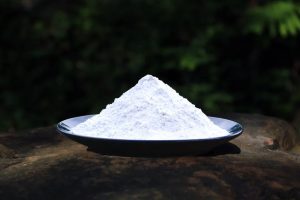We often add calcium carbonate to prepare low price or improve certain performance.
The calcium carbonate that can be applied to the field of plastics is mainly heavy calcium carbonate and light calcium carbonate.
Heavy calcium carbonate and light calcium carbonate have the same chemical formula and similar appearance, but there are great differences in their physical and chemical properties and processing methods.

First of all, the processing methods of the two products are different:
The processing of heavy calcium carbonate is mainly realized by mechanical crushing and grinding; the production of light calcium carbonate is produced through chemical reaction and precipitation. The latter is much more complicated than the former, and the requirements are correspondingly stricter.
Secondly, the physical and chemical indicators of the two products are different, and the differences are as follows:
(1) The bulk density is different. This is the most obvious difference between the two. The bulk density of heavy calcium carbonate is 0.8~1.3g/cm3, the bulk density of light calcium is only 0.5~0.7g/cm3, and the density of nano calcium carbonate products The bulk density can reach below 0.3g/cm3.
(2) Heavy calcium products with different whiteness have relatively more impurities, and the whiteness is generally 89~93%, while the whiteness of light calcium products is generally 92~95%, and some products can reach 96~97%, which is commonly used in light calcium products. The main reason for high-grade or light-colored products.
(3) Heavy calcium products with different moisture content have low moisture content and are relatively stable at the same time, generally 0.2~0.3%, some high-end heavy calcium products can even reach 0.1%; while light calcium products generally have moisture content of 0.3~0.8%, and the moisture is stable Sex is poor, and sometimes there will be certain fluctuations.
⑷Different particle sizes At present, heavy calcium products are only micron-sized products, and the particle size is generally 0.5~45μm, which is obviously larger than that of light calcium. (5) Different crystal forms Heavy calcium products are in irregular shape, also known as amorphous, while light calcium products generally have a more regular crystal form, such as ordinary light calcium is mainly spindle-shaped, while nano-calcium carbonate is mainly cubic crystal form.
The third application process is different. The heavy calcium products are mainly used in papermaking, rubber, plastics and other industries. The filling amount is relatively large, mainly as a volume filler, while the application of light calcium is more extensive, mainly as a volume filler, and the ultrafine calcium is mainly used as a volume filler. (commonly known as nano-scale) calcium carbonate already has the dual roles of functional filler and volume filler, and the filling amount is less.
To sum up, because heavy calcium cannot replace light calcium and the difference in processing cost and application range between the two lead to a large price difference.
As mentioned earlier, due to the large difference in physical and chemical properties of the two products, in terms of the fineness of the product, light calcium carbonate is much finer than heavy calcium carbonate, and light calcium carbonate can be evenly distributed in plastic materials, and the dispersibility It is better, so that the color uniformity of the rubber material, the comprehensive mechanical properties such as the strength, toughness, and fatigue resistance of the rubber material are improved, and the friction coefficient in the production and granulation process of the rubber material is also small, which makes the plastic granulation ability strong. At the same time, the surface of the plastic product is smooth, and the molding ability will be enhanced. However, due to the adsorption force between molecules, the high-fineness fillers are prone to agglomeration, and the reverse will reduce the uniformity and comprehensive mechanical energy of the fillers. Moreover, the sedimentation volume of light calcium carbonate is larger than that of heavy calcium carbonate, which can increase the volume and reduce the weight in plastics.
However, the fine oil absorption value of light calcium carbonate is higher than that of heavy calcium carbonate, the light absorption of the rubber will increase, and the surface of the product will show a sub-surface or matte effect.
Therefore, in the plastic industry, the method of mixing light and heavy calcium carbonate is often used.
Another example is that the main purpose of adding heavy calcium carbonate in the rubber industry is to increase the volume and reduce the cost. The performance of the rubber itself will not be greatly improved, while the light calcium carbonate has the effect of heavy calcium carbonate, and it can also improve the performance of the rubber. There is a certain improvement.
